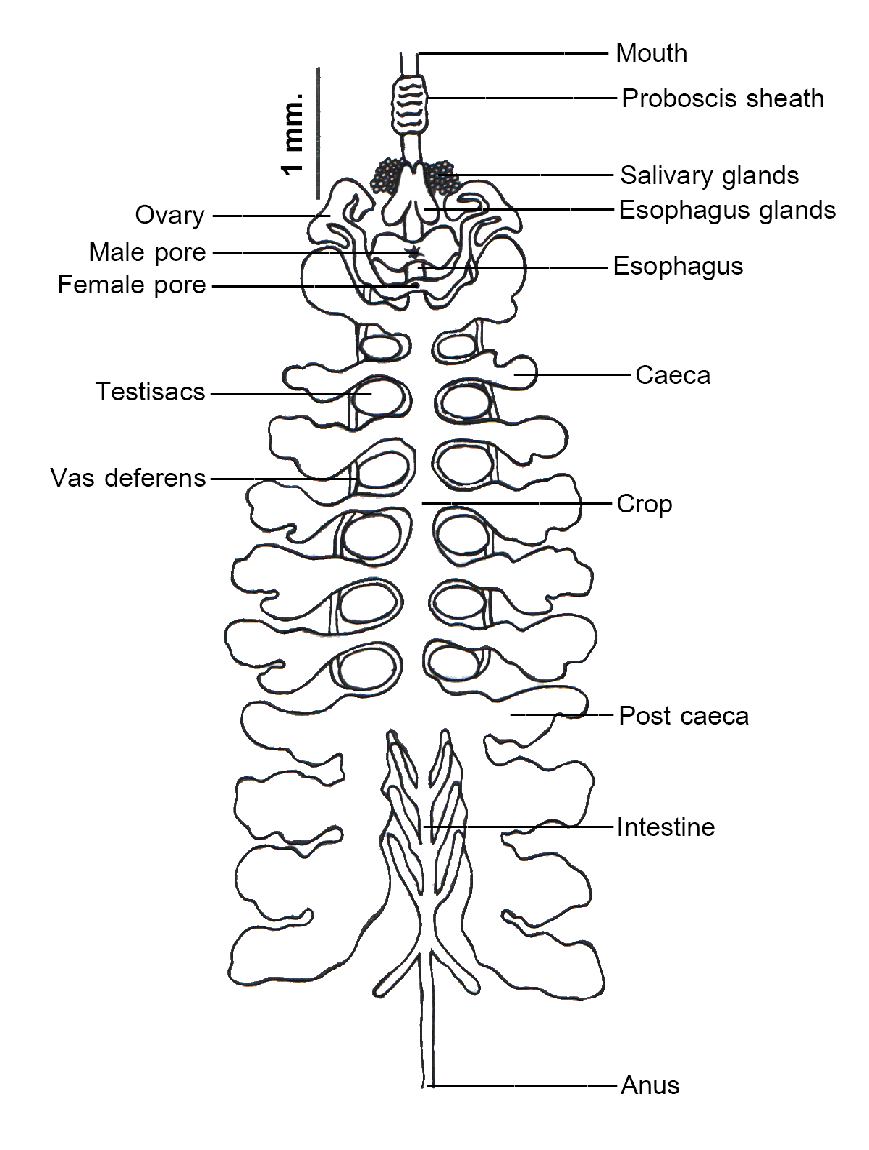
Intestinal caeca of earthworm lies between
A. 22- 26 segments
B. 20- 24 segments
C. 14-16 segments
D. 33-36 segments
Answer
396.3k+ views
Hint: Earthworms are annelids that are found worldwide where soil, water and temperature allow. The body of an earthworm is dissected into a number of segments. The intestinal caeca are found in the alimentary canal.
Complete answer:
Earthworm is a reddish brown terrestrial invertebrate that inhabits the upper layer of the moist soil. The body is divided into more than 100 short segments which are similar. The dorsal surface of the body is marked by a dark median mid dorsal line along the longitudinal axis of the body. The ventral surface is distinguished by the presence of genital openings. Let us first study the general anatomy of earthworms.
a. Circulatory system - 4 pairs of so-called hearts in the segments 7, 9, 12 and 13 and blood vessels. Just after the opening of the animals, the dorsal blood vessel is seen from anterior to posterior end. Lateral esophageal hearts are very distinct in the 12th and 13th segment. Various rounded and red colored blood glands are found below the pharynx. Lymph Glands are present below intestinal caeca associated with blood glands.
2. Alimentary canal- Various parts of the alimentary canal consists of the buccal cavity, pharynx, oesophagus, gizzard, stomach and intestine. Around the pharynx various radial muscles are seen attached from the pharynx to the body wall layer. The intestinal caeca are present in 25th and 26th segment.
3. Excretory system- It has different types of nephridia:
a. Integumentary nephridia- It is found several in each segment.
b. Pharyngeal nephridia- Found in three tufts in 4, 5, and 6 segments.
c. Septal nephridia- From the 15/16 segment and onwards they are attached to inter- segmental septa.
d. Reproductive system- Some of the male reproductive parts are clearly observed anteriorly. The testes sacs are in 10 and 11 segments and the prostate gland is in 16- 20 segments.
5. Nerve system- Nerve ring and some part of the ventral nerve cord below the alimentary canal may be seen.
The intestine starts from the 15th segment and continues till the last segment. Short and conical intestinal caeca project from the intestine in the 25th segment.
So, the correct answer is option A, 22-26 segment.

Note-
Earthworms are hermaphrodite which means testes and ovaries are present in the same individual. There are two pairs of testes present in 10 and 11 segments. A pair of ovaries is attached at the inter-segment septum of the 12 and 13 segment. Four segments from 6 to 9 receive spermatozoa during copulation for fertilization to take place.
Complete answer:
Earthworm is a reddish brown terrestrial invertebrate that inhabits the upper layer of the moist soil. The body is divided into more than 100 short segments which are similar. The dorsal surface of the body is marked by a dark median mid dorsal line along the longitudinal axis of the body. The ventral surface is distinguished by the presence of genital openings. Let us first study the general anatomy of earthworms.
a. Circulatory system - 4 pairs of so-called hearts in the segments 7, 9, 12 and 13 and blood vessels. Just after the opening of the animals, the dorsal blood vessel is seen from anterior to posterior end. Lateral esophageal hearts are very distinct in the 12th and 13th segment. Various rounded and red colored blood glands are found below the pharynx. Lymph Glands are present below intestinal caeca associated with blood glands.
2. Alimentary canal- Various parts of the alimentary canal consists of the buccal cavity, pharynx, oesophagus, gizzard, stomach and intestine. Around the pharynx various radial muscles are seen attached from the pharynx to the body wall layer. The intestinal caeca are present in 25th and 26th segment.
3. Excretory system- It has different types of nephridia:
a. Integumentary nephridia- It is found several in each segment.
b. Pharyngeal nephridia- Found in three tufts in 4, 5, and 6 segments.
c. Septal nephridia- From the 15/16 segment and onwards they are attached to inter- segmental septa.
d. Reproductive system- Some of the male reproductive parts are clearly observed anteriorly. The testes sacs are in 10 and 11 segments and the prostate gland is in 16- 20 segments.
5. Nerve system- Nerve ring and some part of the ventral nerve cord below the alimentary canal may be seen.
The intestine starts from the 15th segment and continues till the last segment. Short and conical intestinal caeca project from the intestine in the 25th segment.
So, the correct answer is option A, 22-26 segment.

Note-
Earthworms are hermaphrodite which means testes and ovaries are present in the same individual. There are two pairs of testes present in 10 and 11 segments. A pair of ovaries is attached at the inter-segment septum of the 12 and 13 segment. Four segments from 6 to 9 receive spermatozoa during copulation for fertilization to take place.
Recently Updated Pages
The correct geometry and hybridization for XeF4 are class 11 chemistry CBSE

Water softening by Clarks process uses ACalcium bicarbonate class 11 chemistry CBSE

With reference to graphite and diamond which of the class 11 chemistry CBSE

A certain household has consumed 250 units of energy class 11 physics CBSE

The lightest metal known is A beryllium B lithium C class 11 chemistry CBSE

What is the formula mass of the iodine molecule class 11 chemistry CBSE

Trending doubts
State the laws of reflection of light

One Metric ton is equal to kg A 10000 B 1000 C 100 class 11 physics CBSE

Difference Between Prokaryotic Cells and Eukaryotic Cells

What is the modal class for the following table given class 11 maths CBSE

How do I convert ms to kmh Give an example class 11 physics CBSE

Give an example of a solid solution in which the solute class 11 chemistry CBSE




